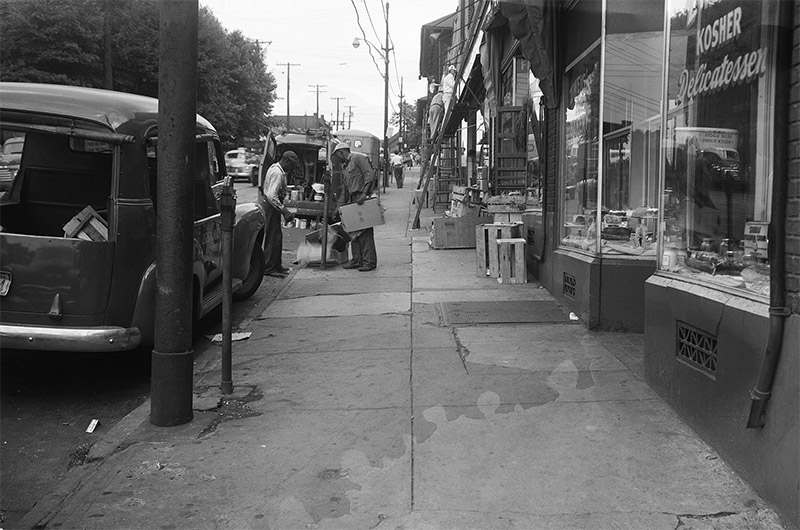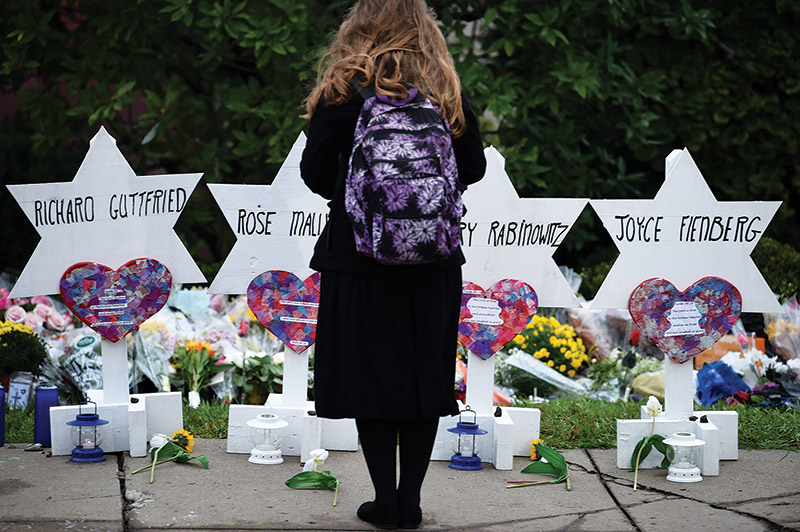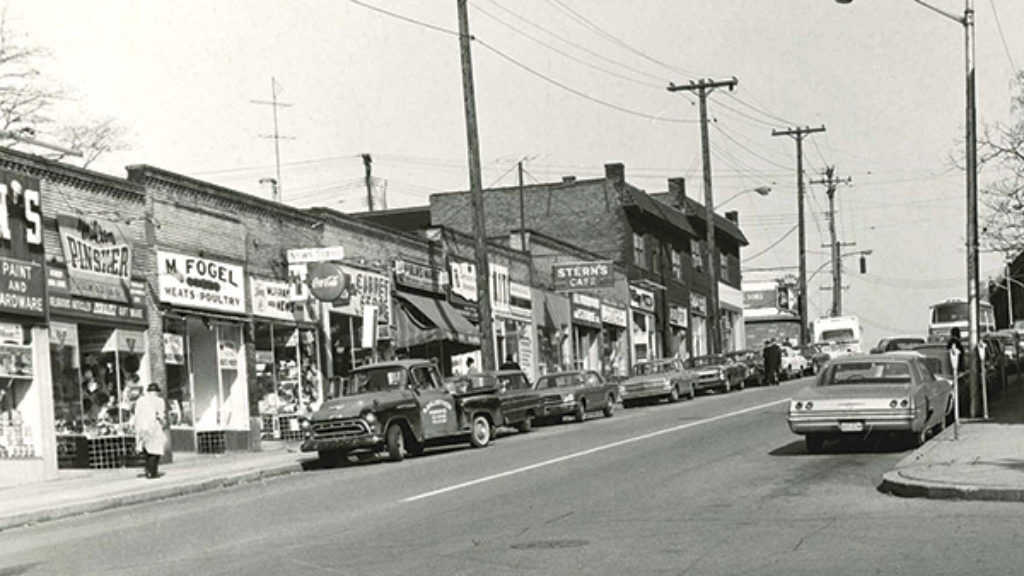From Pittsburgh to the Holocaust
Each anniversary of the 2018 Tree of Life Synagogue shooting—the deadliest attack on a Jewish community in all of American Jewish history—has brought forth a freshly published book.
For the first anniversary, journalist Bari Weiss, who grew up in Pittsburgh and was bat mitzvah at the Tree of Life Synagogue, wrote How to Fight Anti-Semitism. Part history, part analysis, part cri de coeur, the book argued that, in the massacre’s wake, Jews needed to take antisemitism seriously, confront the dangers facing them, and muster the courage to fight back.
For the second anniversary, writer Beth Kissileff and historian Eric Lidji, both of Pittsburgh, produced Bound in the Bond of Life: Pittsburgh Writers Reflect on the Tree of Life Tragedy. Taking its place in the somber tradition of heartrending Jewish chronicles, complete with a martyrology recounting the eleven “Sanctifiers of Life” who were slaughtered (“Eleh Ezkerah, Nusach Pittsburgh”), the book seemed to me, as I wrote in a blurb, to fulfill “a sacred commandment: to recall the tragedy that befell Pittsburgh on October 27, 2018, and never to forget it.”
Now, to mark the third anniversary of the tragedy, journalist Mark Oppenheimer, whose great-great-great-grandfather was one of the founding fathers of the Pittsburgh Jewish community back in 1846, offers Squirrel Hill: The Tree of Life Synagogue Shooting and the Soul of a Neighborhood, a detailed and well-written account of the massacre itself. This bookfocuses panoramically on the tragedy and those it touched, with discrete chapters titled “The Attack,” “Those Inside,” “The Young,” “The Funerals,” “The Trump Visit,” and so forth. Years from now, when people want to know what happened in Pittsburgh, this is the book to which they will probably turn.
Oppenheimer visited Pittsburgh thirty-two times and conducted some 250 interviews in a bid to get the story right. As a result, even those who followed the episode closely will learn fresh details concerning what happened. For example, it was widely reported that the shooter, Robert Bowers, just happened to target the Tree of Life Synagogue; his real goal was to kill as many Jews as possible. Oppenheimer demonstrates that Bowers actually did target Tree of Life. The Reconstructionist congregation Dor Hadash, one of the three congregations that met in the building, had proudly added its name to the HIAS (formerly the Hebrew Immigrant Aid Society) website listing almost three hundred nationwide gatherings for National Refugee Shabbat, aimed at raising awareness about the global refugee crisis. That, according to Oppenheimer, triggered Bowers’s rage. Blaming HIAS for bringing “invaders” into the country “that kill our people,” he loaded up his semiautomatic rifle and three handguns and consciously drove to that synagogue’s address. “I can’t sit by and watch my people get slaughtered. Screw your optics, I’m going in,” he infamously declared on the social media platform Gab.
Another widely reported story that Oppenheimer debunks was that the attack occurred amid a bris, a baby’s circumcision ceremony. A Pennsylvania state senator, the state attorney general, the New York Times, the Washington Post, and a host of other media outlets reported this “news,” a few appending to it the “fact” that the baby’s parents were gay. Oppenheimer explains:
As it happened, there was a baby-naming ceremony in Pittsburgh that morning—for a girl, the second daughter of a gay male couple—but it took place at Rodef Shalom, the large Reform temple just north of Squirrel Hill.
At Tree of Life, twenty-one worshippers and one custodian occupied different rooms of Tree of Life that morning; the youngest worshipper, Oppenheimer reports, was fifty-four years old.
Oppenheimer likewise adds new information concerning the Pittsburgh Post-Gazette’s editor, David Shribman, a Pulitzer Prize winner who won fame again for headlining, on November 2, 2018, the opening words of the Mourner’s Kaddish in bold Hebrew type. A minor spelling error marred that headline—the fault, Oppenheimer reports, of the rabbi who composed the Hebrew on his own computer and provided it to the paper. What few previously knew was that on the very day that headline ran, the Post-Gazette’s owner, unhappy with Shribman’s “grandstanding,” told him to start his planned sabbatical early on January 1 and not to return.
The Tablet magazine podcast Mark Oppenheimer cohosts is called Unorthodox, and he loves unorthodox characters. For instance, he devotes pages to Greg Zanis, the passionate, eccentric, pickup-truck-driving carpenter from Aurora, Illinois, known for placing homemade crosses with handwritten names of the dead upon the sites of mass shootings, a mission he dubbed “Crosses for Losses.” In Pittsburgh, Zanis, who would die of cancer in 2020, sensitively affixed Stars of David to these crosses; they became the centerpiece of a makeshift memorial. Oppenheimer likewise portrays Keshira haLev Fife (née Sarah Gross), who bills herself as a kohenet. “She is a Jew of color, she can sing, she calls herself a priestess, she’s smart, she holds a crowd,” he gushes. “You meet her, and you know immediately why people follow her.” By contrast, the critical if less colorful work performed in the wake of the tragedy by Jewish Federation director Jeffrey Finkelstein, Rabbi Aaron Bisno of Temple Rodef Shalom, and many of the community’s Orthodox and Chabad rabbis largely goes unrecognized here.

What Oppenheimer finds more interesting is Squirrel Hill itself, long the most concentrated Jewish neighborhood of Pittsburgh and also its most populous one, comprising about 26,500 people (more than 40 percent of them Jews) within a 3.89-square-mile area on the city’s east side. In last year’s Bound in the Bond of Life, Molly Pascal captured the Jewish spirit of Squirrel Hill in two words: “urban shtetl.” She explained that “it is pickles and babka and rye.” Asian food establishments outnumber the Jewish ones nowadays, but the city’s most prominent Jewish institutions remain, including several Jewish schools and a self-confident Jewish community center on Forbes Avenue with a permanent menorah and towering Hebrew clocks. Two alluring parks, two nearby universities, a highly rated hospital, and the peculiarities of Pittsburgh geography help explain local Jews’ faithfulness to Squirrel Hill. It remains a Jewish neighborhood more than a century after its earliest synagogues were dedicated around World War I.
Oppenheimer exclaims that Squirrel Hill is unique, “the oldest, most stable, most internally diverse Jewish neighborhood in the United States.” That is an exaggeration: the Jewish community of Brookline, Massachusetts, is about the same age and no less diverse; the Jewish community of Lower Manhattan is much older. Nor is Squirrel Hill truly stable. Where once it was home to over half of the city’s Jews, today, according to the 2017 Greater Pittsburgh Jewish Community Study, that number is 30 percent. By contrast, 44 percent of the community’s Jews have moved out to the suburbs. The membership of Tree of Life Synagogue, as a result, plummeted from 850 families in 1995 to fewer than 250 in 2017. The membership of Rodef Shalom, once one of the largest Reform temples in the country and presided over by the esteemed scholars Solomon B. Freehof and Walter Jacob, dropped from 2,300 families in the early 1960s to about 900. Were it not for the Orthodox Jews, who continue to live within walking distance of their synagogues, the Squirrel Hill Jewish community would have shrunk much further. Even the Orthodox, however, have begun moving. The Pittsburgh eruv, the ritual enclosure established by the Orthodox Jews of Squirrel Hill in 1986 to permit Jews to carry on the Sabbath, has, as a result, been expanded to incorporate Greenfield, much of Frick Park, Oakland, and a bit beyond. The stability that Oppenheimer posits is largely illusory.
Similarly illusory is his assertion, echoing David Shribman, that Pittsburgh is “perhaps the least anti-Semitic city in the country.” Regular readers of the Pittsburgh Jewish Chronicle know better. On March 1, 2000, for example, a Pittsburgh gunman named Ronald Taylor shot and killed three people in nearby Wilkinsburg, Pennsylvania. Anti-white and antisemitic writings were found in his home. Eight weeks later, on April 28, 2000, in South Hills, the largest Jewish suburb of Pittsburgh, a racist, antisemitic, mentally ill immigration attorney named Richard Baumhammers fatally shot his sixty-three-year-old next-door neighbor, a Jewish woman named Anita “Nicki” Gordon, then set her house on fire. Over the following hours, he killed two Asian restaurant employees, murdered one Indian-grocery-store customer and left the manager paralyzed, and fatally shot an African American man in a karate studio. During his rampage, he also stopped to fire his gun into two synagogues: Beth El Congregation, where he also spray-painted two red swastikas, and the Carnegie Shul (Ahavath Achim), the community’s oldest congregation. In Bound in the Bond of Life, Toby Tabachnick, editor of the Pittsburgh Jewish Chronicle,characterized that event—and not the Tree of Life massacre—as “the last day I felt safe as an American Jew.” That horrific day in South Hills nevertheless goes unmentioned in most accounts of the massacre, Oppenheimer’s included. Recalling it, and reading back issues of the Pittsburgh Jewish Chronicle, serves as a reminder that antisemitism was not nearly as alien to the city as boosters would have us believe. To the contrary, in 2000, in the wake of the antisemitically motivated wave of crimes there, the American Jewish Committee’s David Shtulman wrote of “hatred run amok in Pittsburgh.”
In retrospect, neither antisemitism (“hatred run amok”) nor philosemitism (“the least anti-Semitic city in the country”) fits Pittsburgh or, for that matter, most cities with significant Jewish communities in the US. Instead, both themes simultaneously characterize their history, shocking incidents of antisemitism occasionally puncturing long periods marked by goodwill and communal peace. Wikipedia’s comprehensive “list of attacks on Jewish institutions in the United States”—twenty-five of them since 1999, including two in the Pittsburgh area—is important as much for its brevity as for its length. It gives the lie to the ridiculous claim that Jews, having become “white folks,” no longer face any hatred at all in the United States, even as it rebuts the equally ridiculous claim that America is somehow akin to Nazi Germany in the 1930s.
Oppenheimer shows how Pittsburgh united in the wake of the synagogue shooting, much as Boston did following the marathon bombing of 2013. Liberal and Orthodox Jews came together, he reports, as did Jews and Gentiles. He highlights acts of chesed that took place in the wake of the tragedy: gifts of food and cards and teddy bears, visits from celebrities, a widely distributed graphic design mash-up of the Pittsburgh Steelers logo and the Star of David bearing the message “stronger than hate.” He portrays a nonobservant Jew who, following the shooting, started to wear a yarmulke to look more Jewish and a non-Jew “who decided after the shooting to become one.” His story, he thinks, is “about the power of proximity, how the streets we walk affect how we treat each other.” The characters in his book, he writes, faced the mass shooting together “because they had no choice, because they were neighbors.”

One senses that the people of Squirrel Hill also came together because of a shared Holocaust trauma, a fear that the single event in Jewish history that they all had studied and knew about was somehow being reenacted before their very eyes. Beth Kissileff reports that her daughter and her ninth-grade classmates gathered to process the fact that people they knew “had been slaughtered by someone who hated Jews just as surely as those who had taken European Jewish lives in the past. An event we had all thought consigned to history was now very much present.”
One of the valedictorians at the famed Allderdice High School in 2018 exclaimed that “the same hatred that led to mass genocide three-quarters of a century ago is again rising in our home country.” Recently, it was announced that Daniel Libeskind, child of Holocaust survivors and the architect of the Jewish Museum of Berlin and Holocaust monuments in Ottawa and Ohio, will transform the Tree of Life Synagogue building into a space for “worship, reflection and commemoration,” incorporating not only the synagogue but also the Holocaust Center of Pittsburgh. For American Jews who themselves never experienced the Holocaust, the Tree of Life tragedy has thus become something of a shared link to the Shoah right here in the United States.

Emma Green, writing in The Atlantic on the first anniversary of the Pittsburgh massacre, wrote that “America has already forgotten the Tree of Life shooting.” She predicted that “with each anniversary, the Pittsburgh attack will slip further into the great fog of forgetting, swallowed up by the latest national political drama or by workaday life.” Oppenheimer’s book, along with the two that preceded it, and now the promise of Libeskind’s permanent memorial indicate that she was wrong. The reason is that she classified the Tree of Life tragedy as part of the history of mass shootings in America, akin to Columbine and Parkland and Sandy Hook. By that measure, the Tree of Life shooting has now slipped to number twenty-three on Wikipedia’s macabre list of deadliest mass shootings in the United States, tied with the little-remembered 1975 Easter Sunday massacre in Hamilton, Ohio. That, however, is not the way the Tree of Life shooting is being remembered. Instead, it increasingly serves as evidence that the Holocaust can happen here in the United States. In fact, according to some, it almost did.
Suggested Reading

Pittsburgh Jews, Squirrel Hill, and the Tree of Life
In the wake of the recent massacre, a local historian tells the story of the Pittsburgh Jewish community and the 154-year-old Tree of Life synagogue.
Digital Anti-Semitism: From Irony to Ideology
From tweeting trolls to digital incitement, a contemporary history.

Jewish Pittsburgh in Pictures
There is more to discuss in the coming weeks and months, but today instead of words we offer images.
Learning from History
Jonathan Sarna looks back at a time when both Reform and Orthodox Judaism in America seemed imperiled.
Comments
You must log in to comment Log In